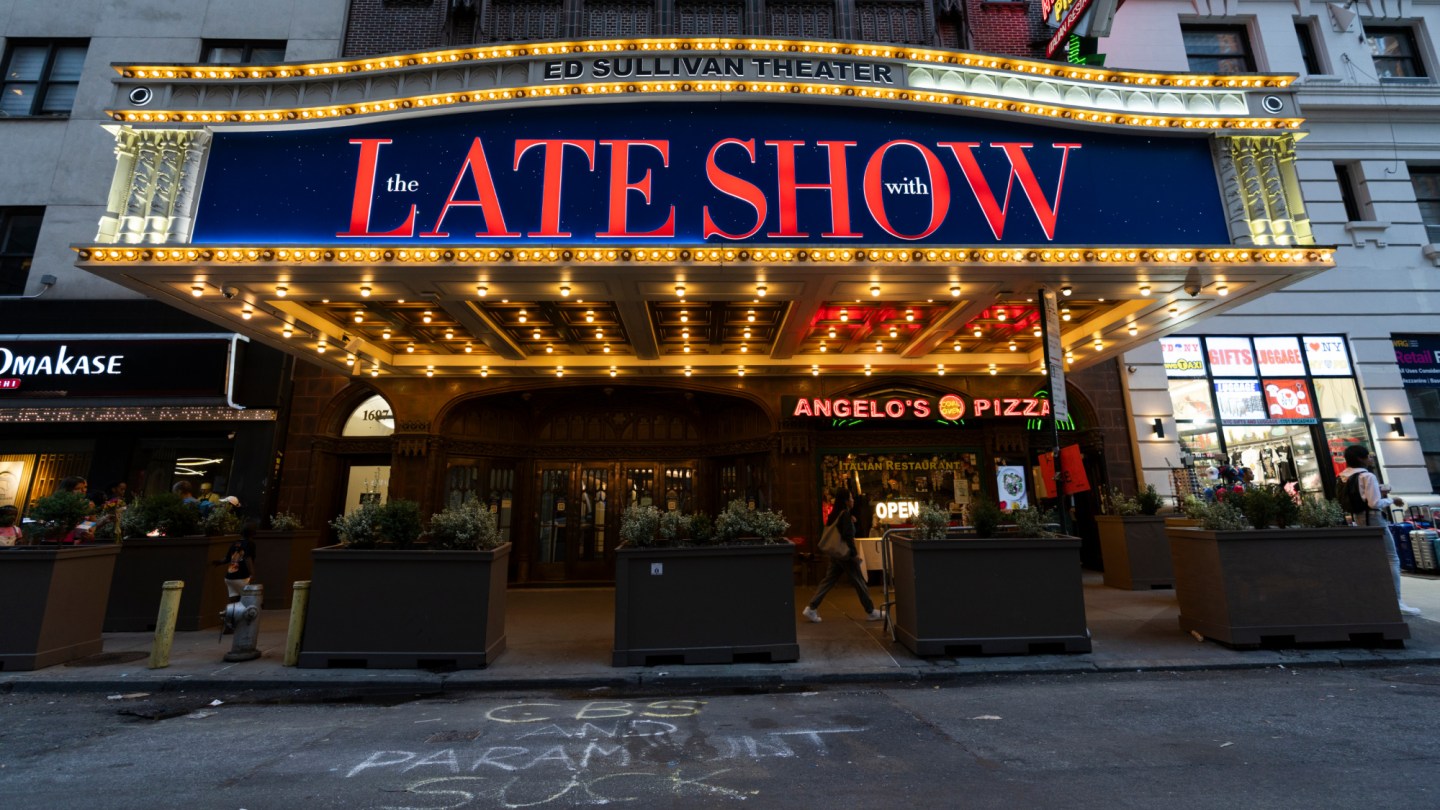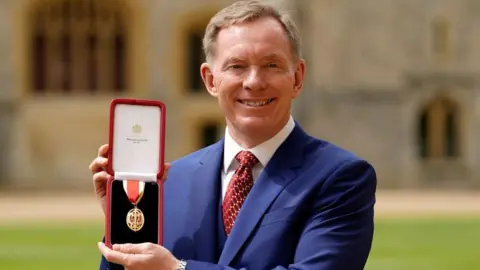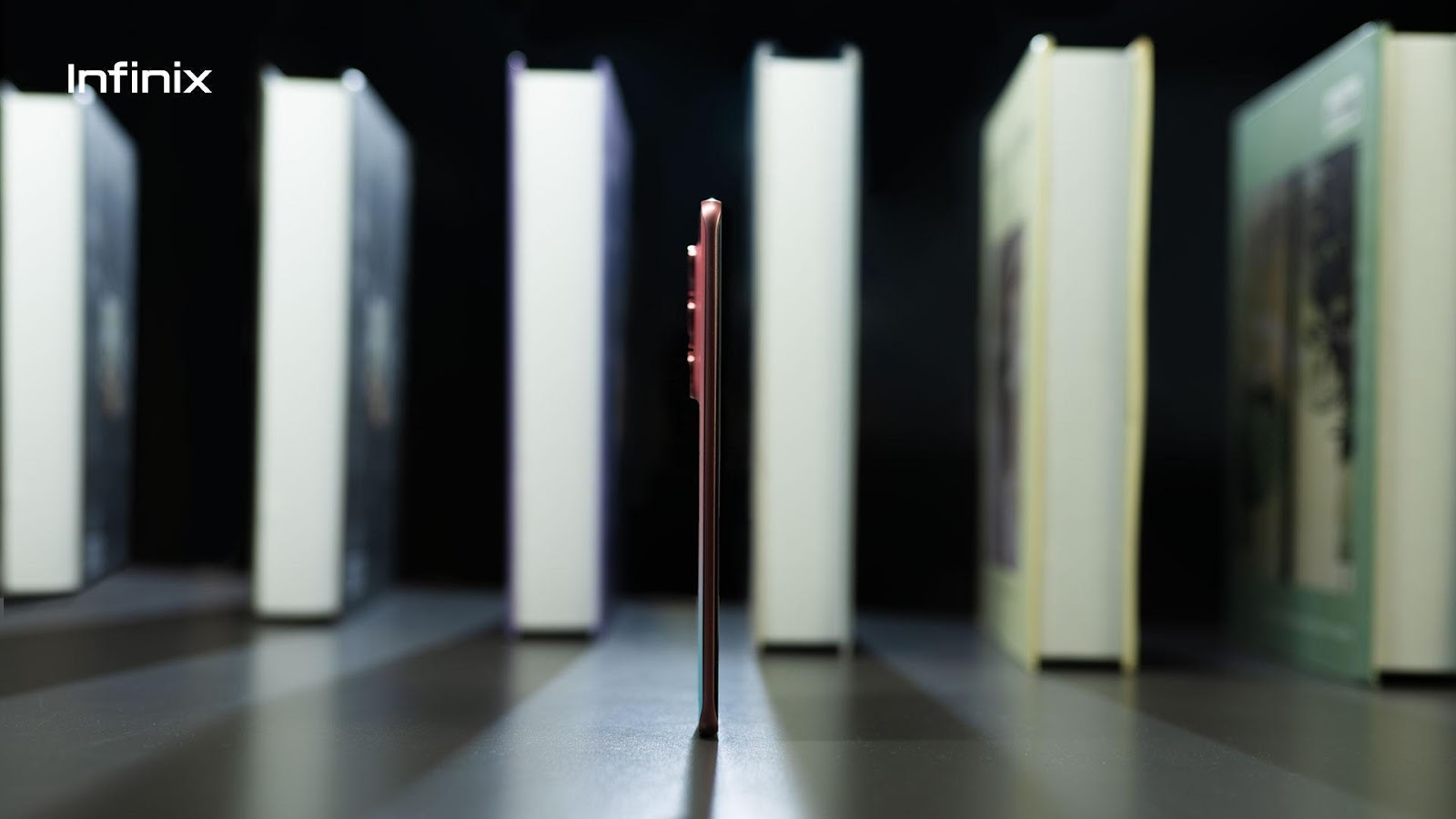In the if-these-walls-could-talk sweepstakes, the Ed Sullivan Theater might never shut up. Built in 1927, located at 1697-1699 Broadway between 53rd and 54th streets, and in more or less continuing operation ever since, it has been home to virtually every great entertainment medium — theater, vaudeville, silent cinema, radio and television — that is not rendered in pixels. The upcoming eviction of the latest tenant (as of May 2026, CBS is tossing The Late Show With Stephen Colbert Show to the curb) prompts a look at the storied history of the house named for one of the least charismatic people ever to have performed there.
The venue began life as the Hammerstein Theater, a legitimate house (that is, a home for hard-ticket theatrical productions) built by Arthur Hammerstein in honor of his father, the wealthy cigar maker turned theatrical impresario Oscar Hammerstein. Arthur bankrolled the building with $3 million in profits from his wildly successful 1924 operetta Rose-Marie, whose book and lyrics were written by his son Oscar Hammerstein II and Otto Harbach, with music by Rudolf Friml and Herbert Stothart. It was formally dedicated on Dec. 3, 1927.
Designed by architect Herbert J. Krapp, the Hammerstein was a monument to Jazz Age excess. The interior alone was worth the price of admission: ten stained glass windows, each illustrating one of Hammerstein senior’s hit theatrical productions, a $50,000 pipe organ, an orchestra pit that could be raised or lowered for 50 musicians, mosaics, Czechoslovak rugs and a $18,000 bronze statue of Hammerstein senior sculpted by Pompeo Coppini.
“The house, which seats 1265, is like a Gothic cathedral,” marveled a visitor. In addition to stage musicals such as Sweet Adeline (1928) and Good Boy (1928), it also served as an extravagant motion picture art house, capitalist Arthur being a cinephile with a penchant for Soviet agit-prop. He imported Vsevolod Pudovkin’s The End of St. Petersburg (1928) and commissioned a special score by Herbert Stothart, played by a full orchestra. Top seats went for $1.50.
The son did not honor his father for long. In 1931, beaten down by the Great Depression and a string of flops, Arthur filed for bankruptcy (he had $5.77 in his account), and the theater was sold at public auction.
The Hammerstein kept going for the next few years under various names — Billy Rose’s Music Hall (where it perked up as a cabaret theater) and the Manhattan (where it staged a hit Federal Theatre Project production of T. S. Eliot’s Murder in the Cathedral). In 1936, it got the first of its many second lives when it was purchased by CBS and converted into a radio soundstage. The network spent $25,000 installing broadcast equipment and soundproofing the house. Now called Playhouse No. 3 and seating 1,269 (adding four seats?), it was the network’s largest studio-theater in New York.
The early days: CBS Radio Playhouse number 3 on Oct. 1, 1936.
CBS via Getty Images
In the golden age of radio, Playhouse No. 3 spotlighted a full roster of CBS stars before the microphone. Audience-friendly performers such as Kate Smith, Benny Goodman and sports commentator Ted Husing found it “a laughy, intimate place where the audience is very apt to get jolly and take off its shoes.” After the conclusion of each broadcast of Camel Caravan, host Walter O’Keefe invited the folks to stick around, watch the rehearsals for the next show and provide feedback. “Our rehearsal audiences are so intelligent that we hope to train them to write our shows within the next few weeks,” said O’Keefe.
During World War II, Playhouse No. 3 served as the main stage for Command Performance, the popular military-minded variety show “recorded and short-waved every Sunday to America’s armed forces all over the world, written and produced under supervision of the Radio Branch of the Bureau of Public Affairs of the War Department.” In 1944, a typical show might have Bob Hope wisecracking, Judy Garland singing “Somewhere Over the Rainbow” and, by special request, Lana Turner frying a sizzling steak, thereby satisfying two GI appetites at once. When Frank Sinatra performed, his bobbysoxer fangirls were sequestered in the balcony to prevent them from rushing the stage. In 1950, television ousted radio from the premises and CBS converted Playhouse No. 3 “to full time television purposes and for AM-TV simulcasts.” It was rechristened Studio 50.
As in the radio days, Studio 50 was the preferred venue for television performers who craved the contact high of a live audience, none more so than the star of The Jackie Gleason Show. “Gleason manages everything around Studio 50 except the refreshment counter at the back of the theater,” said TV Guide in 1954. Among the things he managed around Studio 50: Gleason demanded that the electric applause signs be removed, bellowing. “When my audience has to be told when to applaud, I’ll get out of this business!”

Ed Sullivan and Ethel Waters on Oct. 2, 1949, during ‘Toast of the Town.’
CBS via Getty Images
But the performer (to stretch the definition of the word) most identified with Studio 50 was Ed Sullivan. Born in New York on Sept. 28, 1901, Sullivan first entered show business behind a typewriter as a Broadway columnist for the New York Evening Graphic in 1929 before moving over to the New York Daily News in 1932, where he had a byline for the next 42 years. From the base camp of his syndicated column, he expanded his reach to stage, radio, and film. In the late 1930s, editor-publisher Billy Wilkerson offered him the editorship of The Hollywood Reporter, but Sullivan was too ur-New York to defect to the left coast.
In June 20, 1948, always with a keen eye for the next showbiz hustle, Sullivan jumped into the embryonic medium of television to host a variety show, Toast of the Town. It was a vintage example of “vaudeo,” featuring a smorgasbord menu of entertainment options for every taste — Italian opera, Russian ballet, comedians slick and Borscht Belt, puppets, acrobats and every type of vocalist from every type of playlist. Originally telecast from Studio 44 (the Maxine Elliot Theatre) before moving to Studio 50 in 1953, it was one of the first shows to be kinescoped — filmed off TV and then shipped out to LA for re-broadcast. Sullivan familiarized televiewers with the interior space by introducing celebrities from the audience, whose names he would often muff.
“Sullivan, as an emcee, is a good newspaper columnist” was Variety’s acid remark upon viewing his first show in 1948. True enough — but somehow he clicked. Why the untelegenic Sullivan succeeded in television is a question McLuhanite media scholars have long puzzled over. Perhaps the explanation is as simple as Sullivan knew his limitations: cede the spotlight to the professionals. Fred Allen, the great radio star who never really made the transition to television, quipped that “Ed Sullivan will never go broke as long as other people have talent.” Over time, Sullivan’s eminently imitable lack of personality — robotic stature, expressionless countenance, (“the great stone face”) and nasal enunciation (“we’ve got a really big shue tonight!”) gave impressionists, professional and otherwise, a sure-fire bit for mimicry, which they often performed on Sullivan’s show. (The shtick has had an astonishingly long shelf life: even my Gen Z students recognize him as the model for the MC at Jack Rabbit Slim’s in Quentin Tarantino’s Pulp Fiction.)

Circa 1951: The exterior of the then-named CBS Television Studio 50.
CBS via Getty Images
In 1955, Toast of the Town was renamed The Ed Sullivan Show. For most its run, it was a ritual fixture on Sunday nights at 8 p.m., back in the day when a single television broadcast could unite Americans in a kind of “consensual nightly séance.”
The unity wasn’t all in the mind. Unlike many theaters in America in the 1950s, Sullivan’s Studio 50 was an integrated space for performers and audiences alike. From 1948 onward, he showcased what the trade press still called “colored talent” or “sepia performers.” In 1953, a year before Brown v. Board of Education, Sullivan informed the Pittsburgh Courier, “In the beginning I was told not to shake hands with Negro performers, and I was criticized when I put my arms around Ethel Waters or Joe Louis.” He then rattled off a partial list of the Black entertainers he was proud to have hosted: Lena Horne, Eartha Kitt, Cab Calloway, the Deep River Boys, Dorothy Dandridge, Phil Moore’s Flock and “all the major Negro sports figures and so many others [who] have appeared on Toast of the Town.”
Accused by racists of “fouling” the airwaves and pressured by advertising agencies to adopt a whiter lineup, Sullivan told “sponsors to go hang and slam away,” euphemisms for his more colorful expletives. (Sacha Jenkins’ Best Sunday: The Untold Story of Ed Sullivan, an overdue documentary on Sullivan’s televisual contribution to the civil rights movement, has just dropped on Netflix.)
In a not unrelated casting decision, Sullivan welcomed another integrationist impulse. On Sept. 28, 1956, after having been clobbered in the ratings by Steve Allen on NBC, Sullivan booked Elvis Presley for the first of three appearances, with the television cameras framing Elvis above the waist (“to keep his swivel hips under wraps”). On Jan. 6, 1957, to reassure Mom and Dad, Sullivan bestowed his benediction. “I wanted to say to Elvis Presley and the country that this is a real, decent fine boy.”

Elvis Presley during his second appearance on ‘The Ed Sullivan Show’ on Oct. 28, 1956.
CBS via Getty Images
After the ratings bonanza that was Elvis, Sullivan maintained an open admissions policy for rock and roll. As much as the Fillmores East or West, the stage at Studio 50 tracked the high renaissance of 1960s rock, bequeathing an archival treasure trove for future rock-documentarians — the Rolling Stones changing the lyrics of “Let’s Spend the Night” together to “Let’s Spend Some Time Together,” the Doors refusing to change the lyrics to “Light My Fire, and, on Feb. 9, 1964, the Beatles, who were not asked to change their lyrics, giving baby boomers their second and far happier shared generational memory. (David Tedeschi’s irresistible 2024 rock-doc Beatles ’64 makes a good case for Beatlemania being the psychic cure for JFK assassination trauma.)
On Dec. 10, 1967, for the show’s 20th anniversary, CBS changed the name of Studio 50 to the Ed Sullivan Theater, its present shingle. CBS-TV president Thomas H. Dawson praised Sullivan for making the theater the “Sunday night entertainment crossroads of the world” and noted that the host was “the first television personality in history to have a Broadway theater bear his name.” During the dedication ceremonies, telecast on Sullivan’s regular broadcast, New York Mayor John Lindsay escorted Sullivan out on the street to unveil the new marquee. The great stone face beamed. The curtain finally came down on The Ed Sullivan Show in 1971 and on Sullivan in 1974.

A crowd gathers under the marquee outside the Ed Sullivan Theater at Broadway and 53rd Street on March 17, 1968.
CBS Photo Archive/Getty Images
After Sullivan left the building, the vacancy sign lit up, but there were few renters. Carol Burnett — who in 1959 was introduced on The Garry Moore Show, which was telecast from Studio 50 — remained loyal to the place, at least when she was in New York. She chose it for Bob Randolph’s 6 Rms Riv Vu, in which she starred with Alan Alda, taped before a live audience and telecast on March 17, 1974. “It’s a great theater,” she said, recalling her performances there in Calamity Jane (Nov. 12, 1963) and Once Upon a Mattress (June 3, 1964).
In 1982, the venue was taken over by Reeves Teletape Studios, which undertook its own revisions for multi-purpose television use, “from audience participation to talk shows; from network sitcoms and series to game shows, from telethons to Broadway drama and musicals.”
CBS’ Kate & Allie (1984-89) taped each episode there before two live audiences, by which time a New York produced sitcom was an anomaly. After Kate & Allie, though not quite shuttered, the venue saw little action.
It was the bitter Late Night War of Succession of 1991-92 that gave the theater a new lease on life. When David Letterman bolted NBC for CBS, his new network wanted to welcome him in a manner to which he was not accustomed. In a “restoration project that could be as large as any in the history of television,” the Ed Sullivan Theater underwent yet another major renovation and refurbishment for Letterman’s network debut on Aug. 30, 1993. “Really big venue for Letterman,” headlined THR.
“The theater clearly needs a great deal of work to restore it to the showplace it once was,” understated CBS senior vp operations and administration Ed Grebow, who like everyone who hires a contractor got sticker shock when the final bill came due. CBS paid $4 million to re-acquire the theater and at least another $4 million to bring the place up to code and Letterman specs (CBS is coy about the final price tag). Desperate to keep a flagship production in the city, New York sweetened the deal with tax incentives. “Even when no Velcro is involved, we Daves have to stick together,” quipped New York Mayor David Dinkins.

David Letterman and Barbara Walters talking on the ‘Late Show With David Letterman’ set at the Ed Sullivan Theater in 1993.
Steve Fenn/Disney General Entertainment Content via Getty Images

The Letterman era begins: The Ed Sullivan Theater on Aug. 30, 1993.
CBS via Getty Images
Architect James Stewart Polshek, whose firm had restored Carnegie Hall, was hired for the makeover. “Our job is to protect the ghosts: to keep the ghosts of Cary Grant and Jerome Kern right here, to restore the spirit of what was,” he promised.
Whatever the final cost, it was worth every penny. The 1936 retooling for radio had obscured the beauty of the original plasterwork and stained-glass windows. Then there was the leaky piping, fire-trap wiring, carcinogenic asbestos, and rats “larger than cats,” by Polshek’s estimate. CBS made room for 1,200 spectators, who were advised to bring a sweater: Letterman insisted on a temperature of 62 degrees.
Borrowing from televisual mentors Steve Allen and Ernie Kovacs, Letterman continued to use his workplace as he had at NBC’s 30 Rock as fall guy, straight man and special featured attraction. He and his guest stars ran up and down the aisles and accosted the audience, exited and entered from the side doors, and generally ran rampant. He violated the proscenium arch to wander the streets outside and give 15 minutes of fame to the local shopkeepers and food cart vendors.
On May 20, 2015, when Letterman vacated the premises, Colbert moved in for the very next season, on Sept. 8, 2015. Decoration-wise, he was relatively low maintenance. The marquee was restored to its 1927 style and the name “C-O-L-B-E-R-T” was signposted in gratifying, ego sized lettering down the front of the building. “Believe me, I don’t host a show without my name out front,” he told television critic Bill Carter in THR.

Stephen Colbert changes a light bulb on The Ed Sullivan Theater marquee during ‘The Late Show With Stephen Colbert’ taping on Dec. 3, 2015.
James Devaney/GC Images
But not for much longer. And this time CBS has no one waiting in the wings to take up residence — an indication that the network sees not just Colbert but the whole late show business model as a relic of the bygone age of three network hegemony. Televisual séances are no longer nightly, much less consensual, which is why the move by CBS is seen as a portent of a more general house cleaning over at NBC and ABC.
For now, at least, the only wrecking ball being swung is at Colbert. As for the Ed Sullivan Theater, it was designated a historical landmark in 1988, so the building, if not the late show format, will still be standing for its centennial in 2027.

The Ed Sullivan Theater on July 18.
Craig T Fruchtman/Getty Images









